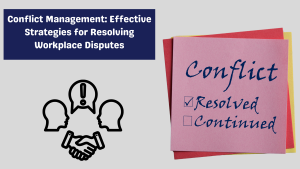
Conflict Management: Effective Strategies for Resolving Workplace Disputes
- Mastering Conflict Management
- Important Conflict Management Techniques
- Conflict Management Implementation
Introduction
Workplace conflicts inevitably arise due to contrasting viewpoints, objectives, or interpersonal factors. A productive and peaceful work environment depends on effective conflict management. This article examines essential tactics for improving communication, settling conflicts at work, and fostering a healthy company culture.
Discover practical methods for handling conflicts at work. Learn strategies for settling conflicts, improving dialogue, and creating a happy workplace.
Mastering Conflict Management
1. Explaining Conflict Resolution
The practice of discussing and resolving disagreements between individuals or groups at work is known as conflict management. It includes a range of methods and approaches intended to resolve conflicts positively, preventing them from getting out of hand and upsetting the workplace.
2. The Value of Dispute Resolution
Managing conflicts well is essential to preserving a healthy work environment and encouraging teamwork. A culture of respect and collaboration is promoted, stress levels are lowered, and problems are kept from worsening when disagreements are resolved promptly and constructively.
Important Conflict Management Techniques
1. Paying Attention
A key element of conflict management is active listening. Before answering, one must pay close attention to and comprehend the speaker’s point of view. Demonstrating empathy and respect via active listening can assist in reducing tensions and promoting productive communication.
2. Honest Communication
Open communication to resolve disagreements must be encouraged. Establish a space where team members may freely voice their worries and ideas. Finding mutually acceptable solutions and determining the underlying reasons for disagreements are made easier with transparent communication.
3. Establishing Shared Objectives
Concentrate on determining what interests and aims the opposing parties have in common. Focusing on common goals can help you coordinate efforts to find a cooperative solution. This strategy promotes teamwork and helps identify points of agreement.
4. Conciliation and Assisting
It may be advantageous in some circumstances to use an impartial third person, such as a mediator or facilitator. Mediators assist in directing conversations, controlling feelings, and assisting in bargaining. Their unbiased viewpoint can help arrive at a just and equitable conclusion.
5. Positive Criticism
Giving constructive criticism is crucial for resolving conflicts and fostering better relationships. Feedback should be given constructively and encouragingly, emphasizing particular actions above personal qualities. Positive transformation is encouraged, and people can better grasp the consequences of their actions when they receive constructive criticism.
6. Creating Explicit Rules
Effective dispute management may be achieved by implementing explicit policies and standards for conflict resolution. Ensure that staff members comprehend the methods of resolving concerns and know the protocols for handling disagreements. Clear guidelines provide an organized approach to conflict management.
7. Fostering an Upbeat Culture
Preventing and resolving disputes is greatly aided by cultivating a healthy workplace culture. Encourage a respectful, inclusive, and cooperative atmosphere. Promote team-building exercises and give workers the chance to communicate honestly and productively.
Conflict Management Implementation
1. Education and Training
Give them the chance to learn and grow in conflict resolution techniques. Employees can acquire the skills to resolve problems through negotiation, emotional intelligence, and communication workshops and seminars.
2. Observation and Assessment
Observe and assess the organization’s dispute resolution procedures regularly. Evaluate the success of the tactics put into practice and make any necessary changes. Approaches to conflict management are kept current and valuable through ongoing review.
3. Promoting Input
Invite staff members to offer their opinions on dispute resolution procedures. Getting feedback from those directly involved in disputes can assist in pinpointing problem areas and improving overall conflict resolution initiatives.
Conclusion
Sustaining a productive and happy work environment requires effective conflict management. Through the application of techniques like mediation, open communication, and active listening, organizations may effectively handle conflicts and promote a cooperative atmosphere.
Creating an environment of mutual respect and offering continuing education facilitates efficient dispute resolution and creates a productive and peaceful workplace.
